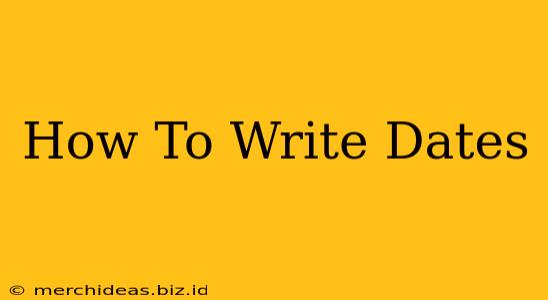Writing dates might seem simple, but there's more to it than you might think. Different countries and organizations use different formats, and inconsistencies can lead to confusion and errors. This comprehensive guide will walk you through various date formats, styles, and best practices to ensure your writing is clear, accurate, and universally understood.
Understanding Different Date Formats
The most common formats for writing dates fall into three main categories:
1. Month-Day-Year (MDY):
This format is prevalent in the United States, and uses a sequence like October 26, 2024. It's important to note that the month is spelled out, and a comma separates the day and year.
Example: October 26, 2024
2. Day-Month-Year (DMY):
Many countries, including the United Kingdom, Canada, and Australia, prefer the Day-Month-Year format. In this format, the day comes first, followed by the month and year. Again, the month is usually spelled out.
Example: 26 October 2024
3. Year-Month-Day (YMD):
This format is often used in scientific publications and databases to ensure consistent chronological order. It's also gaining popularity in some regions. The year is written first, followed by the month and day, usually in numerical format.
Example: 2024-10-26
Choosing the Right Date Format: Key Considerations
The best date format to use depends heavily on your context:
- Audience: Consider your target audience's location and cultural norms. Using a format familiar to your readers will improve readability and reduce ambiguity.
- Style Guide: If you're writing for a specific publication or organization, adhere to their style guide for date formatting. Many style guides (like the Chicago Manual of Style) provide clear guidance on date conventions.
- Consistency: Maintain consistency throughout your writing. Once you choose a format, stick to it. Switching between formats within a single document is confusing.
- International Communication: For international communication, consider using the ISO 8601 standard (YYYY-MM-DD), which minimizes confusion across different regions. This is particularly important in digital environments.
Beyond the Basics: Other Date Writing Tips
- Abbreviation: Avoid abbreviating months unless space is severely limited. Spelling out the month is generally preferred for clarity.
- Ordinal Numbers: While not always necessary, using ordinal numbers (e.g., 26th instead of 26) can add a touch of formality.
- Context: If the year is already clear from the context, you might omit it. For example, in a series of events within the same year, you could simply write "October 26".
- Numerical Dates: For numerical dates (like in databases or spreadsheets), using YYYY-MM-DD is the most recommended format for its unambiguous sorting capability.
Mastering Date Writing for Clear Communication
By understanding the nuances of date formatting and following these best practices, you can significantly enhance the clarity and accuracy of your writing. Choosing the appropriate format and maintaining consistency will ensure your dates are easily understood, regardless of your audience's location or background. Remember to always prioritize clarity and consistency for effective communication.
